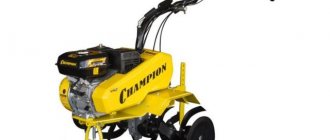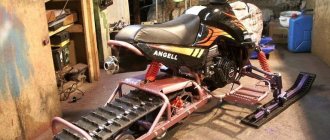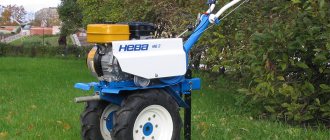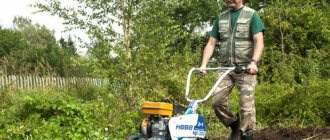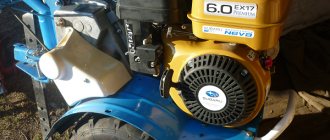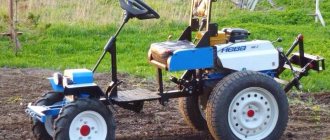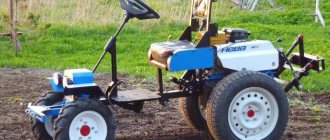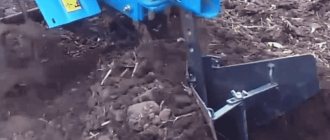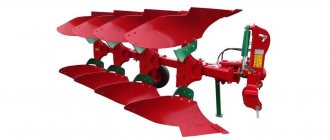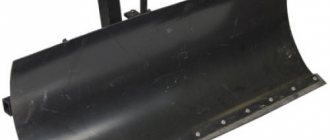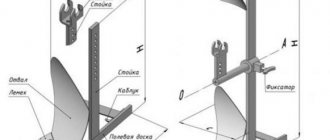By purchasing a Neva walk-behind tractor and its attachments, owners of land plots have powerful and multifunctional agricultural equipment at their disposal. Neva walk-behind tractors have been produced in St. Petersburg for more than 30 years. During this time, the products were repeatedly modified and supplemented with various options. Today, the Neva MB walk-behind tractor is the most popular hand-held equipment, which is distinguished by high quality workmanship, reliability and long service life.
On sale you can find models equipped with engines of domestic, American and Japanese production. Motors produced in St. Petersburg and Voronezh are well suited for a small local area. More powerful foreign engines are used in a field of 1-3 hectares. The presence of a gearbox that allows the machine to move forward and backward makes it possible to carry out various agricultural work in cramped conditions and on winding areas. The ability to extend the base of the axle shaft significantly increases the stability of the machine on slopes and uneven terrain. However, the high functionality of the Neva MB-23 product can only be achieved with attachments purchased from a specialized store or made independently.
Weights for walk-behind tractors
The main problem for the Neva MB walk-behind tractor is slipping on wet ground and on inclines. With a low weight (98 kg), the unit does not exert sufficient pressure on the ground to create reliable traction. Lightweight attachments do not help eliminate this disadvantage.
To increase the weight, the following devices are attached to the motor-cultivator and walk-behind tractor:
- Wheel weights. Factory products are monolithic iron circles or hollow containers filled with sand. Homemade products are not inferior to their factory counterparts in quality. They are made from barbell discs, cast from concrete, or assembled from parts of a metal barrel. The weights are attached to the axle hub. Their weight can be 20-50 kg per wheel.
- Body weights. They are made in the form of a frame from steel corners, rigidly fixed to the frame of the unit. Drawings and calculations are made in advance so that the frame fits exactly into place. Pieces of iron or containers with water/sand are attached to the frame.
- Steel wheels with lugs. These products have a steel strip instead of a tire, to which plates of the same material are welded. The diameter of the lugs varies between 30-70 cm, width - 10-20 cm, weight - 15-50 kg.
By making the walk-behind tractor heavier, you can count on its smooth progress across the site even when cultivating virgin soil. After this, you need to purchase or make your own attachments for the Neva walk-behind tractor. The scope of agricultural activity is quite wide; to cover it all, you will need a wide variety of attachments for the Neva MB-2 walk-behind tractor.
Lugs
Special attachments in the form of lugs are used to allow deep penetration into the ground. Such devices are made of metal wheels with special teeth. The Neva walk-behind tractor is compatible with KMS wheels; one of them weighs 12 kg.
There is also another model of lugs - metal wheels KUM, designed for deep hilling of the earth. Compared to KMS, they are thinner - their thickness is only 10 cm, but their diameter is 70 cm. KUM wheels weigh 15 kg. You need to choose a suitable device based on the specifics of the work you need to perform.
For plowing and cultivating land
There is a generally accepted scheme for cultivating land for planting garden crops or grass. Any work begins with plowing. For this you need a plow and a harrow for the Neva walk-behind tractor. Virgin soil is raised using single-row or double-row plows. The choice depends on the density of the soil and the depth of the root system of the plants growing on it. The mounted plow P1 20/3 allows you to make furrows up to 23 cm deep. The plowing area can be up to 0.1-0.12 ha/h. This is comparable to the efficiency of a mini tractor.
After the soil is plowed, it must be cleared of weeds, branches and debris. You will need a milling cutter and rake for the Neva walk-behind tractor. The cultivator breaks up large clods of earth, and the rake removes foreign objects from it. Most farmers prefer to make their own rakes. Homemade attachments are not inferior to factory-made analogues, and in terms of strength and reliability they can significantly exceed them. The rake is made from sheet metal and reinforcement. The finished product is attached to the frame of the unit with chains or a steel cable.
Owner reviews
Nikolay, 33 years old:
Hello. I am the owner of the OKA 1d1m10 walk-behind tractor. My mini tractor (that’s what I call it) will be 5 years old this year. The machine is strong, time-tested, and simply irreplaceable on a plot of land. He processes my 32 acres without effort. The controls are very simple; breakdowns, of course, do occur, but the benefits far outweigh the temporary inconvenience. Mostly belts fly, the gas tank cap gets lost (jumps off). The machine is noisy, but it completely performs all gardening work. Compact dimensions allow it to fit into a raspberry patch and even into a greenhouse.
For mowing fields and lawns
If there are cows on the farm, then before plowing the field it is advisable to mow the grass from it, which can be dried. Mowing is best done using a mounted rotary mower equipped with blades. This is a fairly large and effective device that makes a strip up to 80 cm wide. In an hour of operation, the Zarya rotary mower can mow up to 0.15 hectares of dense vegetation.
For quick and high-quality hay harvesting, it is advisable to purchase a pick-up for a walk-behind tractor. As a rule, such equipment is used to equip wheeled tractors. However, the design of the Neva walk-behind tractor allows the use of small balers. To reduce manual work to a minimum, you should buy a baler that performs the entire range of operations with mown hay - compacts it, rolls it and ties it with a nylon cord. All that remains for the walk-behind tractor operator to do is attach a trailer to the unit and collect the packed hay into it.
When processing virgin soil, a lot of waste is generated in the form of roots, branches and thick stems. There is no need to rush to burn them or remove them to the edge of the field. Plant scraps can be used to make excellent nutritious compost. To do this, purchase a branch chopper for a walk-behind tractor. With its help, useless garbage is turned into valuable fertilizer. A chopper for a walk-behind tractor can be delivered to the field on a trailer attached to the unit itself or in the trunk of a car. The chips obtained as a result of crushing can be left in place or partially removed for further use in floriculture.
Motoblock Neva MB2, clutch modification
027
DvigAteL
At first I thought that you had the clutch on top - that you had some kind of rollers screwed there. and the clutch is almost exactly how it was made on my walk-behind tractor from the factory - that is, a piece of hardware is attached to the same bolt on the roller on which the cable is attached. and so close to the axis the spring will of course break
I bought a walk-behind tractor MB23 not long ago. And such a problem emerged. or am I doing something wrong. I adjust the clutch so that the gear pulley does not spin in neutral. I literally set it to the millimeter - but when the clutch is pressed, the walk-behind tractor simply does not mill - the engine pulley slips along the belt. If I pull the cable harder, the pulley does not slip and mills normally. BUT the other speed is no longer turned on - the gear pulley is in constant rotation. vicious circle) . What to do?
DZHONIK AS FIRE
Why so many videos? Belt overheating is guaranteed. The Oka Motoblock also has this weak point, there is a lever but it’s turned out, I’ll also weld the eye. and it was enough for you to place dampers near the engine pulley instead of a bunch of rollers. The belt serves for a long time and reliably when its tension is maintained and there is no big break - from my practice. Finished belts are being made now.
Alexander Nikulin
Namesake, thank you very much for the tip on the clutch. A lot has been done in this MB so that I can buy it more often. I’ve had this freak for two years now and I see that it needs to be radically improved, starting with the gearbox axle (a huge drawback - the axle is round). I’m now looking for a hexagonal and wheels to it. And why the hell did I take this motherfucker, no, look at MBs with hex axles and a normal drive without belts with a normal gearbox.
Barmaley
I don’t know how you sell the cables in the kit; there is already a plate that is attached to the same bolt as the tensioner, about seven to eight centimeters long, and the cable is attached to it; you don’t need to invent anything. As for the other spring, if you put a stiffer spring, the cable in the handle starts to tear off, this has already been checked.
Hello Sanya! What a great idea! My hand is getting tired of holding this pen! and according to your method, it should be easier for the hand to travel? Thanks for the idea.
Planting and harvesting potatoes
This vegetable is grown in any farm and in the country garden. When planting a large number of tubers, it is advisable to use the KSM-1 potato planter. This simple and reliable device immerses tubers to a depth of up to 20 cm. The risk of damage to planting material is completely eliminated. To couple with the Neva unit, an adapter is not required, which is a big plus.
The undoubted advantage of the Neva brand walk-behind tractor is that you can attach a KNM potato digger to it. Weighing only 5 kg, this device collects tubers from a depth of up to 22 cm, with a working width of 25 cm. This ensures complete harvesting with minimal chance of damage.
The KV-2 potato digger is more effective. It sinks into the ground up to 25 cm, providing a width coverage of 30 cm. The dimensions of the potato digger are 550x300x440 mm and weighs 3.2 kg.
What is a Neva 2 walk-behind tractor?
The powerful motor unit produced is equipped with three engine options for the walk-behind tractor:
- Gasoline engine produced by the Kaluga plant, the most often used modification is DM-1, DM-2, with a power of 6 and 7 hp. respectively. The first works on the A-76, the second on the A-95. In this case, the letter “K” is added to the walk-behind tractor index according to the instructions;
- American engines from Briggs & Stratton. The version of the walk-behind tractor with the index “B” is considered the most reliable and easy to maintain, even without any instructions;
- Subarov engines, when equipped with them, the Neva walk-behind tractor is assigned the index “C”. The engines have a similar power of 6-7 horses, but there are also diesel versions with colossal torque. The most capricious in maintenance and operation, all operations, even refueling and starting, must be performed only according to the instructions.
To find out what specific fuel is used for a particular walk-behind tractor model, you need to check the passport and operating instructions. For example, an attempt to fill a Subarov engine with 92-octane gasoline during operation can lead to burnout of the piston system, and walk-behind tractors with American Briggs often experienced serious problems with starting and controlling engine speed due to the large amount of dirt in domestic fuel.
- The mass of the unit when charged reaches 100 kg. This is the average for most walk-behind tractors; Chinese heavy versions can reach 150-180 kg;
- Motor power -6 hp, with a torque of 180 kg?s, for a diesel engine the torque is increased to 220 kg?s;
- The plowing depth according to the instructions, when using a standard plow, on a walk-behind tractor reaches 200 mm, the maximum harrowing width is 170 cm.
The machine can plow, harrow, dig up potatoes planted in beds, clear snow and much more, provided that the standard attachments specified in the operating instructions are used.
For soil cultivation
Vegetable gardens, beds and fields must be processed periodically. Otherwise, the earth will become covered with a dense crust, and weeds will clog the garden crops. In order to provide the roots of the plant with oxygen and prevent them from rotting from dampness, the beds are hilled. The purpose of this activity is to create a hollow between the rows of plants and a mound above their roots. Single or double nozzles are used. The double-row hiller weighs up to 15 kg, sinks into the ground by 8-12 cm and covers a width of 35-50 cm. The single-row disc hiller for the Neva walk-behind tractor allows you to process up to 0.2 ha/h at maximum forward speed. The turn is carried out quickly due to the activation of the axle shaft disconnection mechanism. The turning radius is only 110 cm, which greatly simplifies and speeds up work.
Hillers for MB-2 are available in different variations. The disc hiller is used to create furrows for planting various crops, hilling or loosening loose soil. The folding hiller allows you to simultaneously create two furrows for planting and hills up. The width of the flaps and the depth of the furrow are easily adjustable. Before cultivating the soil with this attachment, the manufacturer recommends using a cultivator cutter, which will make the soil looser. The hillers produced by the manufacturer of walk-behind tractors Neva are suitable for all models of walk-behind tractors from this company.
An indispensable device for weed control is a mounted weeder for a walk-behind tractor. This product removes plants from the soil along with the root system, which eliminates the prerequisites for subsequent overgrowing of the beds. The design of the weeder is well thought out. While removing weeds, this device does not affect the stems, tubers and roots of garden crops.
Hiller
The hiller is the most popular type of attachment used on walk-behind tractors. It is made from shaped parts and has a sharp tip that turns into an oval. There are three main types of hillers:
- unregulated;
- adjustable;
- Dutch.
The first hiller has a fixed design.
It is usually used when digging furrows up to 30 cm wide. Non-adjustable hillers are used on low-power walk-behind tractors. The second type of equipment is used in private households. The mechanism of operation of such a hiller resembles the action of a hoe. It can be adjusted to the row spacing. Using this hiller, the hilling depth can be easily adjusted.
The Dutch type of equipment is a cross between the above types of canopies. The height of the stroke and the dimensions of the furrow are set by changing the location of the flaps.
Disc hillers are also used on Neva walk-behind tractors. The distance between the two disks and the bending angle of such equipment are set manually.
Trailed equipment
The capabilities of the Neva walk-behind tractor are not limited to plowing and cultivating soil. Living in a private house is inextricably linked with the need to transport various goods. The design of the unit suggests the possibility of attaching a wheeled trolley or sleigh on runners to it. The trolley is equipped with one or two seats. The location of the operator's seat provides convenient access to the controls of the walk-behind tractor. If necessary, the trolley is equipped with a headlight and parking signals.
The overall dimensions of the trailer are 2200x1130x960 mm with a body size of 1150x835x250 mm. Depending on the model of trailers, their carrying capacity is 150-250 kg, not counting the operator’s weight. The weight of the trailers themselves varies between 85-130 kg. The trolleys are designed to move on level terrain at a maximum speed of 12 km/h with no sharp turns. Driving on curved sections is permitted at a speed of no more than 4 km/h.
Trailed sleds are designed for transporting goods and transporting people through snow and swampy areas. The average size of a sled is 200-250 cm in length, 120-140 cm in width and 20-40 cm in height. The sled is made of plastic and weighs 10-15 kg.
External tuning of the unit
Structurally, light, medium and heavy walk-behind tractors are practically the same. They consist of a power plant, chassis and controls. The operator resembles an ancient plowman, holding the handles of the machine with both hands. However, it is not protected from sunlight, rain, snow and heat coming from the engine. To create additional comfort, you do not need to spend additional money. Everything you need is at hand. External modernization of a walk-behind tractor involves the installation of a removable or permanent awning, an additional protective casing or hood over the power plant.
- roulette;
- building level;
- Bulgarian;
- welding machine;
- electric drill;
- set of wrenches;
- steel or aluminum corner 30 x 30 mm;
- paint brush;
- acrylic paint;
- tarpaulin or cellular polycarbonate;
- flexible plastic.
External modification of the walk-behind tractor is carried out in the following sequence:
- Drawing up drawings. It is necessary to accurately calculate all dimensions of the frame and provide options for attaching it to the frame and handles.
- Carrying out markings, cutting out blanks for the awning, casing, wings and hood.
- Welding a frame from a corner. Drilling mounting holes, cleaning metal from rust, oil and dirt. Painting of the manufactured structure.
- Fitting the frame onto the frame. Marking and making holes in it. Fastening the frame with bolts and nuts, checking the reliability of all connections.
- Installation of plastic casings and awnings on frames.
There is an option to mount the instrument panel on the handle. This way the unit will look solid and representative. The operator additionally gets the opportunity to control the state of the power plant, know the speed of the machine and the distance traveled. When remodeling the walk-behind tractor from the outside, you need to pay attention to ensuring that air freely penetrates to the motor, cooling it efficiently.
Mounted snow removal equipment
Almost all models of walk-behind tractor are adapted for attaching devices for clearing snow from the local area.
The Neva can be equipped with the following snow removal equipment:
- Rotary canopy SMB-1. The product is rigidly fixed to the hitch and connected to the power take-off shaft. The snow blower captures a strip 60 cm wide with a cover height of up to 25 cm. The captured snow is thrown to the side at a distance of 5 m. At average speed, a walk-behind tractor with a snow blower can process up to 150 meters of paths and paths per hour. The rotary mechanism successfully copes with crust and compacted snow.
- Blade knife. It is used for removing snowdrifts and clearing garden paths of fresh snow up to 20 cm deep. Depending on the model of the canopy, the blade width can be 60-100 cm. The manufacturer produces stationary blades and with the ability to adjust the horizontal angle.
- Rotating brush. Designed for cleaning freshly fallen snow on a flat surface (platforms, paths). The working width is up to 90 cm. Some models provide the ability to rotate the rotor mechanism. The weight of the attachment is 50 kg.
After the snow melts, you can attach a pump to the walk-behind tractor. It is used to pump water out of drainage wells, flooded basements and lowlands. The Neva will also help out in the event of an accident on a power line. A portable generator of up to 5 kW is connected to the power take-off shaft, which is quite enough for the full functioning of the house, outbuildings and external lighting.
Manufacturing of additional accessories
Walk-behind tractors go on sale assembled and with minimal equipment. A plow and a cutter are clearly not enough to perform the entire volume of agricultural work. A factory kit for converting a walk-behind tractor can cost more than the unit itself. You can make various attachments and trailers from scrap materials, using tools that are in every pantry of a country house or cottage.
Drawing of cutters for a walk-behind tractor Drawing of a plow for a walk-behind tractor Drawing of a trolley for a walk-behind tractor
It is worth considering some options for making additional equipment yourself:
- A converted rake for collecting grass clippings, debris, branches and fallen leaves. If you do this work manually, it will take a lot of time and effort. Trailed equipment will allow you to clean large areas within a few minutes. To work, you will need a wide strip of sheet iron and several meters of reinforcement with a cross section of 8-12 mm. The reinforcement must be cut into pieces 10 cm long and welded to the plate in several rows and at intervals of 3-4 cm. Long rods are welded to the plate for attaching to the walk-behind tractor frame. Trailed rakes can be equipped with rollers to improve maneuverability and smoothness.
- Snow plow. Most units operate much more efficiently in the cold because they do not overheat. You can mechanize snow removal in winter. The blade is made from two pieces of channel welded together. This allows you to get a gripping height of up to 40 cm. The width of the blade is selected according to the power and weight of the unit within 40-80 cm. The blade is attached rigidly to the front of the machine with bolts. Initially, it can be mobile or stationary.
- Trolley and trailer. The walk-behind tractor cannot be driven on the road, so it does not have to be adjusted to the requirements of the traffic rules. The cart is made from a corner, a channel and old wheels from a small car, and a trailer is attached to it. It is made from metal profiles and boards. The towing clutch is made standard, like for cars or tractors.
Advantages of working with attachments for Neva walk-behind tractors
Attachments significantly save physical and financial resources. By purchasing various units for a walk-behind tractor, the owner gets the opportunity to comprehensively process a house plot or farmland. Attachments significantly increase the productivity of the walk-behind tractor, which is important when working over a large area. The manufacturer offers a large selection of attachments at an affordable price. Photos with descriptions of various units will help you choose equipment to solve a specific problem.
It’s easy to find videos on the Internet in which experts share their experience of working with attachments for the MB-2, and also show how to properly assemble it with a walk-behind tractor:
What attachments for walk-behind tractors do you use?
Power plant tuning
Its power and equipment performance depend on the stability of the engine. Upgrading a standard engine is very expensive and unpromising. But, there are several ways to make the engine more efficient.
- Install a quality spark plug. Regularly clean it from carbon deposits and periodically check the clearance. At the first sign of loss of power, replace the spark plug.
- Use the best gaskets on all connections. This allows you to maintain the required pressure in the unit, preventing a decrease in power and the formation of smoke during operation.
- Fill the engine with the best oil to the upper mark. It should be remembered that when the unit is tilted, oil flows away from the rubbing parts.
- Check the quality of fuel before filling the tank. It is advisable to let it sit for a while so that the water sinks to the bottom of the container. The tank itself must be cleaned and wiped dry every 2-3 days.
- Install an additional radiator. To do this, steel plates are welded to the engine housing, which will effectively remove excess heat.
A radical solution is to replace the power plant with a more powerful and advanced one. Today you can purchase Japanese, Chinese and European engines, which are characterized by high performance and reliability. It is possible that the frame will have to be redesigned to accommodate the new power plant.
All-wheel drive 4x4 walk-behind tractor: a mini tractor from Niva with a do-it-yourself engine
The specifics of life in rural areas presuppose the presence of certain means of small-scale mechanization that help the summer resident in his daily work. This especially applies to farmers who have fairly large holdings, the processing of which by hand is simply impossible.
However, not everyone has enough money to buy a ready-made mini tractor in a store, because its cost can be really impressive.
In such cases, homemade mini tractors made by rural craftsmen are becoming increasingly relevant and worthy of attention. This is quite justified, because this approach to business allows you to significantly save on the purchase of the unit itself, which is the main reason for such homemade products.
This can also be interesting because the assembly process itself can be quite exciting, especially for those people who are partial to technology.
How to make a mini tractor at home. Advantages and disadvantages
A homemade mini tractor, produced and assembled with your own hands, is much cheaper than factory models, and its technical characteristics sometimes even exceed their performance.
It has the following main advantages:
- cheap production;
- it can be made for personal needs;
- parts can be used from old equipment.
Such an assistant is used for many purposes: processing vegetable gardens and orchards, cleaning the site and transporting goods, etc.
Another advantage of this transport is its quick payback. You can get your investment back literally in one season, because the parts from which the tractor is assembled can be removed from old and unnecessary equipment or purchased at very low prices - in the case when the parts have already been used.
Some craftsmen sometimes convert other equipment into mini tractors. This greatly simplifies the process of assembling such an assistant.
If we talk about the disadvantages, we can note the difficulty in selecting the necessary parts. Also, such a device does not have a warranty, unlike new purchased models, and in the event of a breakdown, you need to carry out repairs yourself and buy the required parts. In addition, such a tractor, as a rule, is assembled from old parts and it is not always possible to find a worthy replacement on the market.
Preparing the necessary drawings is not so easy. To do this, you must have minimal drawing skills and work experience. This is necessary because the tractor will be used with other equipment and the engine power must be correctly calculated.
A mini tractor made at home with your own hands must be registered with the traffic police, since the first time you go onto a public road and the police stop the device, you can receive a large fine, and the vehicle itself will be subject to confiscation and end up in a penalty area.
